

| Back to Page 1 | ||
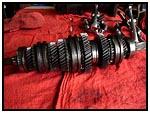 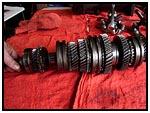 When
you first look at the main shaft, it may appear very daunting. But as long
as you have a large workbench where you can lay everything out in order
(and you have your Factory Service Manual handy) it's not really tough.
This is actually two shafts. The main shaft has the input shaft at one
end. You can see it being carefully removed in the photo to the right. The
high-speed synchronizer ring may be loose on the end of the input shaft
when you separate the shafts, be sure to keep the parts in order. We will
come back to this later. When
you first look at the main shaft, it may appear very daunting. But as long
as you have a large workbench where you can lay everything out in order
(and you have your Factory Service Manual handy) it's not really tough.
This is actually two shafts. The main shaft has the input shaft at one
end. You can see it being carefully removed in the photo to the right. The
high-speed synchronizer ring may be loose on the end of the input shaft
when you separate the shafts, be sure to keep the parts in order. We will
come back to this later. |
||
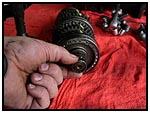 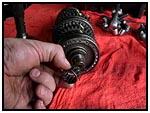 On
the end of the main shaft (where the input shaft had been) you will find a
needle bearing. This is unlike the larger bearings you have already
replaced because there are no ball bearings in it. This kind of bearing is
for close quarters, looking more like a sleeve, it uses long
cylindrical bearings that ride on a larger surface. Set this aside,
keeping the components in a line to insure the right order of assembly. On
the end of the main shaft (where the input shaft had been) you will find a
needle bearing. This is unlike the larger bearings you have already
replaced because there are no ball bearings in it. This kind of bearing is
for close quarters, looking more like a sleeve, it uses long
cylindrical bearings that ride on a larger surface. Set this aside,
keeping the components in a line to insure the right order of assembly. |
||
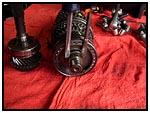 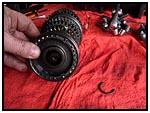 Remove
the circlip, and pull the third gear, synchonizer low speed hub and needle
bearing off all at once. You can keep them together to make it easier, but
remember to replace the needle bearing with a new one from the rebuild
kit. Set it face down on the workbench in its place in the order. Remove
the circlip, and pull the third gear, synchonizer low speed hub and needle
bearing off all at once. You can keep them together to make it easier, but
remember to replace the needle bearing with a new one from the rebuild
kit. Set it face down on the workbench in its place in the order. |
||
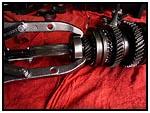 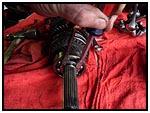 Starting
at the other end of the main shaft, carefully remove each bearing, and its
set of gears and put them in line on the table. Starting
at the other end of the main shaft, carefully remove each bearing, and its
set of gears and put them in line on the table. |
||
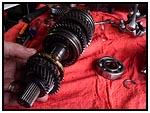 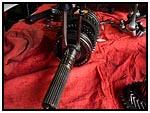 There
are circlips along the way that retain each gear set, so don't force
anything until you have checked for one of these suckers. There
are circlips along the way that retain each gear set, so don't force
anything until you have checked for one of these suckers. |
||
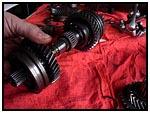 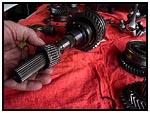 Your
rebuild kit should include all of the main bearings as well as the needle
bearings, so remember to swap in the new components as you go. Your
rebuild kit should include all of the main bearings as well as the needle
bearings, so remember to swap in the new components as you go. |
||
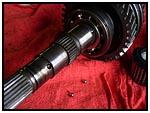 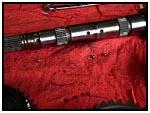 As
you (carefully) pull the main shaft assembly apart, you will notice three
(3) ball bearings in the mix. Don't lose these. Also, don't try to remove
a component if there is a ball holding the component in place. Carefully
remove the ball and place it in the assembly order. As
you (carefully) pull the main shaft assembly apart, you will notice three
(3) ball bearings in the mix. Don't lose these. Also, don't try to remove
a component if there is a ball holding the component in place. Carefully
remove the ball and place it in the assembly order. |
||
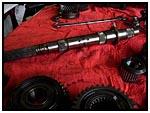 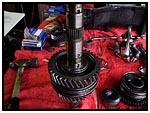 Once
the shaft has been disassembled, go back through the parts you have removed
and make sure you replace all of the bearings with new components that
look identical. Once
the shaft has been disassembled, go back through the parts you have removed
and make sure you replace all of the bearings with new components that
look identical. |
||
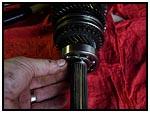 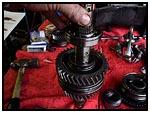 Then
reassemble the shaft in the reverse order that you took it apart. This is
where keeping everything in order makes the difference. Then
reassemble the shaft in the reverse order that you took it apart. This is
where keeping everything in order makes the difference. |
||
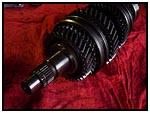 For
a reminder of the order, take a look at this.
The main bearings will need to be pressed back into place, so be careful not
to lose track of the ball bearings shown above. For
a reminder of the order, take a look at this.
The main bearings will need to be pressed back into place, so be careful not
to lose track of the ball bearings shown above. |
||
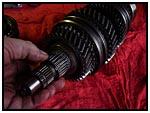 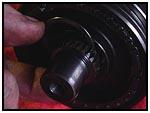 The
needle bearings should slide easily with no obstructions. And don't forget
the circlips as you go. The
needle bearings should slide easily with no obstructions. And don't forget
the circlips as you go. |
||
 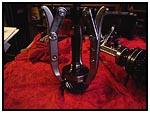 Remember
the input shaft we set aside earlier? You will need to replace the bearing
on the end of the input shaft. Use a bearing puller for removal and then
press the new bearing into its place. Then slide the input shaft back onto
the main shaft over the new needle bearing. Remember
the input shaft we set aside earlier? You will need to replace the bearing
on the end of the input shaft. Use a bearing puller for removal and then
press the new bearing into its place. Then slide the input shaft back onto
the main shaft over the new needle bearing. |
||
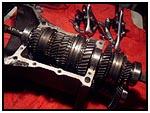 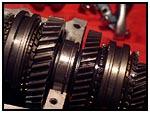 As
you carefully place the main/input shaft back into place, be sure to
notice the circlips on the main bearings. These ride in a slot that will
keep the bearing race from moving after assembly. Make sure everything
rotates smoothly. As
you carefully place the main/input shaft back into place, be sure to
notice the circlips on the main bearings. These ride in a slot that will
keep the bearing race from moving after assembly. Make sure everything
rotates smoothly. |
||
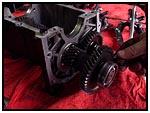 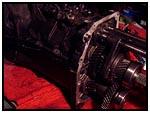 Bolt
the upper case back into place and torque to factory specs. Put the idle
gear/ reverse gear shaft back into place. Bolt
the upper case back into place and torque to factory specs. Put the idle
gear/ reverse gear shaft back into place. |
||
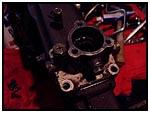 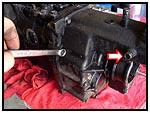 Bolt
the extension case back into place and don't forget the reverse shift rim
bolt that we pointed out earlier. Then we concentrate on the shift tower. Bolt
the extension case back into place and don't forget the reverse shift rim
bolt that we pointed out earlier. Then we concentrate on the shift tower. |
||
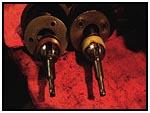 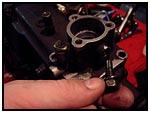 The
shifter locating bolt is a commonly replaced item, as it is very prone to
wear. There are two different sizes based on the model year of your
transmission. You can see an example of each shifter to the right. The
shifter on the left of the photo is a newer model, as it has the wider
slot to accept a larger locating pin. On the right, you can see an older
model that has also been outfitted with a new poly shifter 'sheet'. These
replacement shifter sheets are available from many of the aftermarket distributors. Planning
ahead, we got this one from North
Coast Offroad during the ZookiMelt last year. The
shifter locating bolt is a commonly replaced item, as it is very prone to
wear. There are two different sizes based on the model year of your
transmission. You can see an example of each shifter to the right. The
shifter on the left of the photo is a newer model, as it has the wider
slot to accept a larger locating pin. On the right, you can see an older
model that has also been outfitted with a new poly shifter 'sheet'. These
replacement shifter sheets are available from many of the aftermarket distributors. Planning
ahead, we got this one from North
Coast Offroad during the ZookiMelt last year. |
||
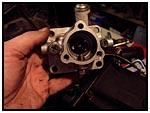 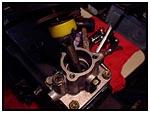 Here
you can see the shifter tower after a cleanup and lube. A new locating
bolt has been installed and because this is an older model shifter tower,
we used the shifter handle with the new shifter sheet described above. Here
you can see the shifter tower after a cleanup and lube. A new locating
bolt has been installed and because this is an older model shifter tower,
we used the shifter handle with the new shifter sheet described above. |
||
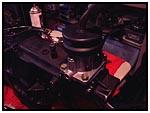 If
your shift tower needs to be replaced, maybe the threads for the locating
bolt are stripped out - or you have an older model and would like to take
advantage of the larger diameter locating bolt of the newer model, you can
get a complete tower kit from Hawk
Strictly Suzuki. If
your shift tower needs to be replaced, maybe the threads for the locating
bolt are stripped out - or you have an older model and would like to take
advantage of the larger diameter locating bolt of the newer model, you can
get a complete tower kit from Hawk
Strictly Suzuki. |
||
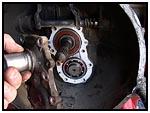 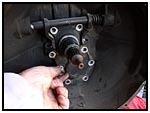 Here
we finally close up the case by replacing the input shaft housing. Here
we finally close up the case by replacing the input shaft housing. |
||
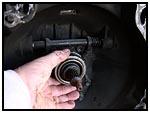 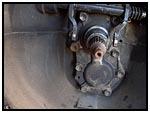 Finally
a new clutch release bearing (aka - the throwout bearing) tops off the
input shaft. Remember to replace the pilot bearing in your flywheel also,
or you may experience a situation where the vehicle still wants to move
with the clutch depressed. Sometimes it's the little things that get you! Finally
a new clutch release bearing (aka - the throwout bearing) tops off the
input shaft. Remember to replace the pilot bearing in your flywheel also,
or you may experience a situation where the vehicle still wants to move
with the clutch depressed. Sometimes it's the little things that get you! |
||
Important things to note here...
|
||
| Component Sources:
Petroworks Offroad
Products North Coast
Offroad
|
08/22/22 14:14:00